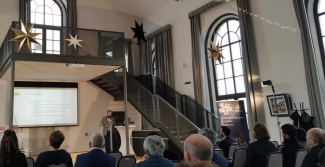
After last year's event in Pécs (see details here), the Mohács500 conference took place in Mohács on December 7, 2023, with the collaboration of the Fraknói Research Group.
In the first section chaired by Tamás Fedeles, Gábor Nemes and Tamás Kruppa delivered presentations. Gábor Nemes discussed the military expenditures of the Győr Cathedral Chapter based on data extracted from the medieval accounting book of the chapter between 1500 and 1526. He established that despite not being counted among the bandarim-holding landowners according to the 1498 20th regulation, from 1502, the Győr Cathedral Chapter evidently had mercenaries. Among these mercenaries were both mounted (heavy and light cavalry) and foot soldiers, each with their own captain and flag. The financial burden of paying wages and providing arms, clothing, and food strained the canons financially; they had to finance war expenses from their own incomes alongside military taxes.
Tamás Kruppa analyzed the immediate papal envoy reports preceding the Battle of Mohács. Despite these sources being long-known, they received little attention from historiography. He argued that the contemporary historical narrative of Ottoman-Hungarian diplomatic relations between 1524 and 1526 was incomplete and one-sided. Kruppa's new research results helped nuance this one-sidedness, demonstrating that the Hungarian side, before the Mohács catastrophe, was willing to pay tribute to the Ottoman Court for peace. According to the mentioned Vatican sources, there existed a specific document, although now lost to us, confirming this willingness for payment.
The afternoon session began with Viktor Kanász, who presented previously unknown 16th and 17th-century German and English works from Savoya, detailing the Battle of Mohács in depth and its consequences. He emphasized how the memory of the battle sparked interest across Europe in subsequent generations, transcending regions and denominations. The events were often interpreted in a stereotypical manner, highlighting the image of the young king, the reckless commander, and the stereotype of decline. This illustrates how the early modern European intelligentsia thought about Mohács and 1526.
Tamás Fedeles presented the Hungarian ecclesiastical council during the reign of King Louis II, analyzing its composition based on prosopographical methods. His presentation revealed that most of the era's 24 bishops were versed in humanistic culture, with many honing their minds at Italian universities. In terms of origin, common nobles constituted the majority, outnumbering the baronial, bourgeois, and serf families' offspring. Furthermore, most bishops were associated with Tamás Bakóc and György Szatmári, the era's two chief chancellors. Fedeles also outlined the preparatory work for a comprehensive ecclesiastical history handbook, the Late Medieval Bishop Lexicon (1458-1526).
The conference also featured the presentation of the study collection titled "The Sunken Mohács," which included writings by Gábor Nemes, Tamás Kruppa, and Viktor Kanász.
